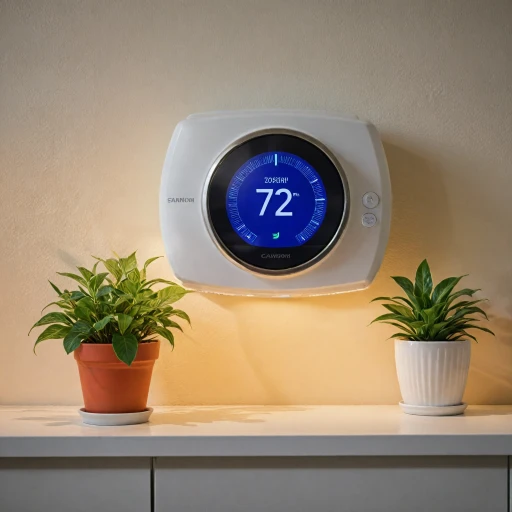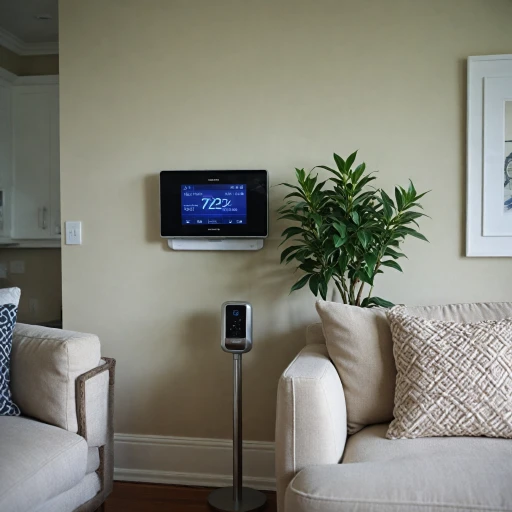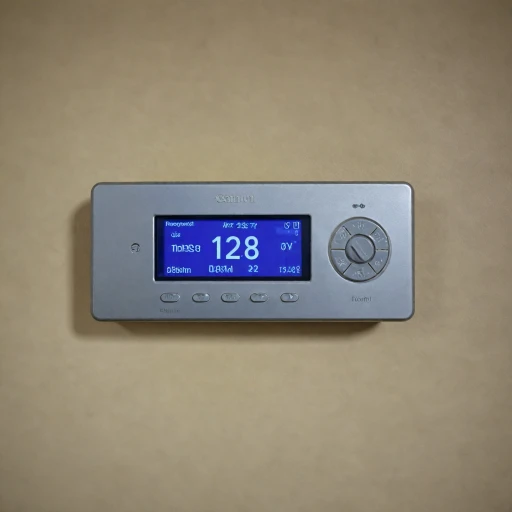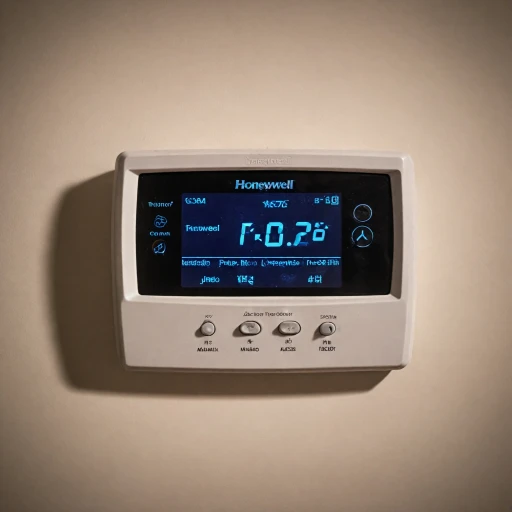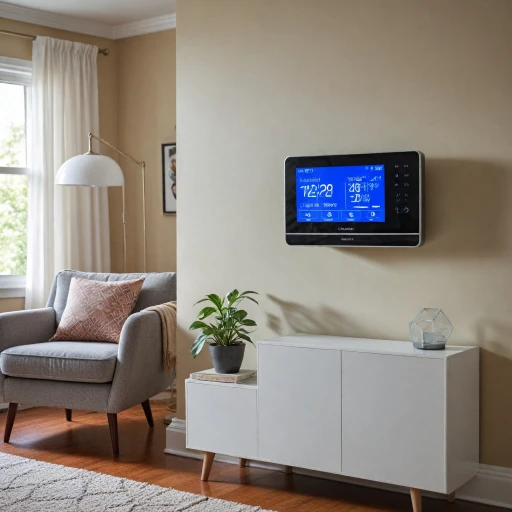
Understanding Smart Thermostats
Introduction to Smart Climate Control
Smart thermostats have revolutionized the way we manage indoor temperatures, bringing a level of convenience and efficiency unrivaled by traditional devices. By integrating internet connectivity and sophisticated temperature sensors, these devices allow precise control over home climates, tailoring them to personal preferences while optimizing for energy savings.Key Features of Smart Thermostats
Smart thermostats are rich with features that cater to various homeowner needs:- Intelligent Learning: Devices like the Nest Learning Thermostat adapt to your schedule, automatically adjusting settings to provide optimal comfort and efficiency.
- Remote Access: With wireless capabilities, adjustments can be made remotely via apps, ensuring a comfortable home environment awaits your arrival.
- Integration with Smart Home Ecosystems: Many smart thermostats, such as Honeywell's smart solutions, seamlessly integrate with platforms like Google Nest and Amazon Alexa, adding further accessibility and control options.
- Comprehensive Climate Management: Advanced models include indoor and outdoor temperature sensors, adjusting heating and cooling systems more precisely.
Leading Smart Thermostat Products
Several prominent brands dominate the smart thermostat market, offering diverse pricing and features suitable for varying needs:- Ecobee: Known for its superior sensor technology, Ecobee smart thermostats provide detailed climate control, often praised in customer reviews for ease of use and energy efficiency.
- Google Nest: Widely recognized for its learning capabilities and sleek design, Nest thermostats are frequently chosen for their seamless integration and modern interface.
- Honeywell Smart: Offering robust connectivity and compatibility, Honeywell thermostats are a trusted choice for those seeking reliability and smart home compatibility.
The Role of Remote Sensors
The Impact of Remote Sensors on Home Climate Control
In recent years, the concept of remote sensors has become an integral part of smart thermostat systems, transforming how we manage indoor comfort. These sensors play a pivotal role by actively monitoring the temperature across different rooms, allowing the central thermostat to make informed decisions about adjusting the heating or cooling system. This innovation is mighty useful for those who desire individualized climate control in specific areas of their homes.
Remote sensors communicate wirelessly with the main thermostat. They detect variations in a room’s climate and relay this data back to the central unit. As a result, smart thermostats like Nest, Honeywell smart, and Ecobee can better manage indoor temperatures, helping to maintain optimal comfort temperature levels.
The advantage of deploying these sensors is the ability to achieve more even climate control throughout the house. For instance, rooms that typically remain cooler than others, such as those located in basements or shaded areas, can be adjusted independently. By doing so, you can mitigate any temperature discrepancies that occur naturally in different parts of the home.
Most modern thermostats like the Google Nest learning thermostat offer compatibility with these smart room sensors, ensuring comprehensive coverage and control. It’s also worth noting that leveraging wireless remote sensors can contribute to energy savings by preventing overuse of heating or cooling in rooms that do not require it.
Customer reviews on platforms like Amazon generally showcase satisfaction with these products, often citing the greater control over household climates and eventual energy cost reductions. For those contemplating integrating remote sensors with their smart system, understanding their extended benefits can be illuminating. For more insights into how elements like an attic fan enhance home comfort, visit our comprehensive guide on the role of an attic fan with thermostat.
Benefits of Using Thermostats with Remote Sensors
Experience Comfort Like Never Before
The integration of thermostats with remote sensors brings a whole new dimension to managing your home's comfort. With brands like Honeywell, Nest, and Ecobee leading the charge, these products are designed to offer smarter control over your indoor climate. Whether through wireless connectivity or precision temperature sensors, these systems aim to maintain the desired indoor environment.
Maximize Energy Savings
Smart thermostats and remote sensors provide major energy savings by learning your habits and making automatic adjustments. For example, a Nest learning thermostat can identify when a room is unoccupied and adjust the temperature accordingly, saving energy and lowering bills. Brands like Honeywell and Ecobee are also equipped with multi-room sensors that allow for customized temperature control, ensuring efficient heating and cooling.
Seamless Integration and User-Friendly Controls
Control is at the heart of the smart room experience. With products that integrate easily with popular voice assistants like Alexa, managing your room’s climate is effortless. This seamless control complements a wide range of household systems, making the transition to a smart thermostat solution both simple and effective.
Confident Choices Supported by Customer Insights
Before making a purchase, it's wise to rely on customer reviews available on platforms like Amazon to find highly-rated products that suit your needs. Stars and reviews can guide you to thermostats that have proven efficient in maintaining optimal temperature and service quality.
Navigating price points can also factor into your decision, with various options available that cater to different budgets. For current users or those seeking upgrades, considering learning thermostat models by Google Nest or evaluating the thermostat gen makes for a worthy investment in home comfort.
Be Prepared for a Seamless Installation
Lastly, ensure smooth operations by acquainting yourself with necessary installation steps. For insights on setting up a Honeywell smart thermostat, especially when circumstances require a reset, the recommended guide is a valuable resource. Learn how to do it effortlessly.
Challenges in Implementing Smart Thermostats
Overcoming Installation Hurdles
Implementing a smart thermostat system in your home can be a game-changer for comfort and energy savings. However, the journey isn't always smooth. One of the primary challenges is the installation process. While many products, like the Nest thermostat or Honeywell smart thermostats, are designed for user-friendly installation, the reality can be different. Homes with older wiring systems might require professional assistance, which can increase the overall cost. Additionally, integrating remote sensors in multiple rooms can be tricky, especially if your home has thick walls or multiple floors that might interfere with wireless signals.
Compatibility Concerns
Another hurdle is ensuring compatibility with existing heating and cooling systems. Not all smart thermostats work seamlessly with every HVAC setup. For instance, some older systems might not support the advanced features of a learning thermostat like the Nest Learning Thermostat. It's crucial to check the compatibility of your chosen product with your current system to avoid any functionality issues.
Connectivity and Security Issues
Smart thermostats rely heavily on internet connectivity for remote control and smart features. A stable Wi-Fi connection is essential for optimal performance. Without it, you might face difficulties in controlling the temperature remotely or accessing energy savings data. Moreover, as with any smart device, security is a concern. Ensuring that your thermostat and sensors are protected against potential cyber threats is vital. Regularly updating the device's firmware and using strong passwords can help mitigate these risks.
Price and Value Considerations
The initial investment in a smart thermostat and accompanying sensors can be significant. Products from brands like Ecobee or Google Nest often come with a higher price tag. While customer reviews on platforms like Amazon often highlight the long-term energy savings, it's important to weigh these against the upfront costs. Evaluating the potential return on investment, in terms of energy savings and enhanced comfort, is essential before making a purchase.
Choosing the Right Thermostat and Sensor for Your Home
Key Considerations for Choosing the Right Smart Thermostat
Selecting the ideal smart thermostat and remote sensor for your home can significantly impact your comfort levels and energy efficiency. With a myriad of products available on the market, from brands like Honeywell to Ecobee and Nest, it's important to consider several key factors before making your purchase.- Compatibility with Existing Systems:
- Integration with Smart Home Devices:
- Remote Sensing Capabilities:
- Energy Efficiency Features:
- Price Point:
- Customer Reviews and Ratings:
- Installation and Support:
Future Trends in Smart Thermostat Technology
Advancements in Technology and Innovation
Smart thermostats continue to evolve swiftly, driven by advancements in technology and innovative product offerings from leading brands. Companies are pushing boundaries, improving functionality and efficiency as they cater to consumer demands for enhanced home comfort and energy savings.
Integration with Home Automation Systems
One prominent trend is the integration of smart thermostats with broader home automation systems. This includes seamless compatibility with voice assistants like Amazon Alexa and Google Nest, enabling hands-free control and interaction. As these integrations become more sophisticated, users can anticipate a higher level of intuitive control over their heating and cooling schedules.
Enhanced AI and Learning Capabilities
AI-driven algorithms are increasingly prevalent in smart thermostats. With models like the Nest Learning Thermostat, these devices learn user preferences and behavior to optimize temperature settings. This intelligent adaptability not only ensures comfort but also promises potential energy savings by automatically adjusting temperatures based on the analysis of occupancy patterns.
Improved Indoor and Outdoor Temperature Monitoring
The use of remote sensors continues to refine how smart thermostats manage temperatures. These sensors can provide real-time data on both indoor and outdoor conditions, allowing for dynamic adjustments. Products like the ecobee thermostat utilize these sensors to optimize room climates, ensuring each space in the home remains comfortable and energy-efficient.
Increasing Emphasis on Data Privacy and Security
As with any connected device, data privacy and security are paramount. Manufacturers are prioritizing the development of secure communication protocols between devices and the cloud, ensuring users can trust their smart thermostats. This includes encryption measures and regular software updates to ward off potential vulnerabilities.
Affordability and Accessibility
As technology advances, the price of smart thermostats and accompanying systems is expected to decrease. This trend will likely enhance accessibility for a broader audience, making smart temperature control a feasible option for more households. Customer reviews and stars on platforms like Amazon indicate growing satisfaction as consumers find affordable options that meet their expectations.
The landscape of smart thermostats is rapidly maturing, highlighting a future where homes are more responsive and aligned with user needs. Stay informed on these innovations to make the most of your smart home investments.

